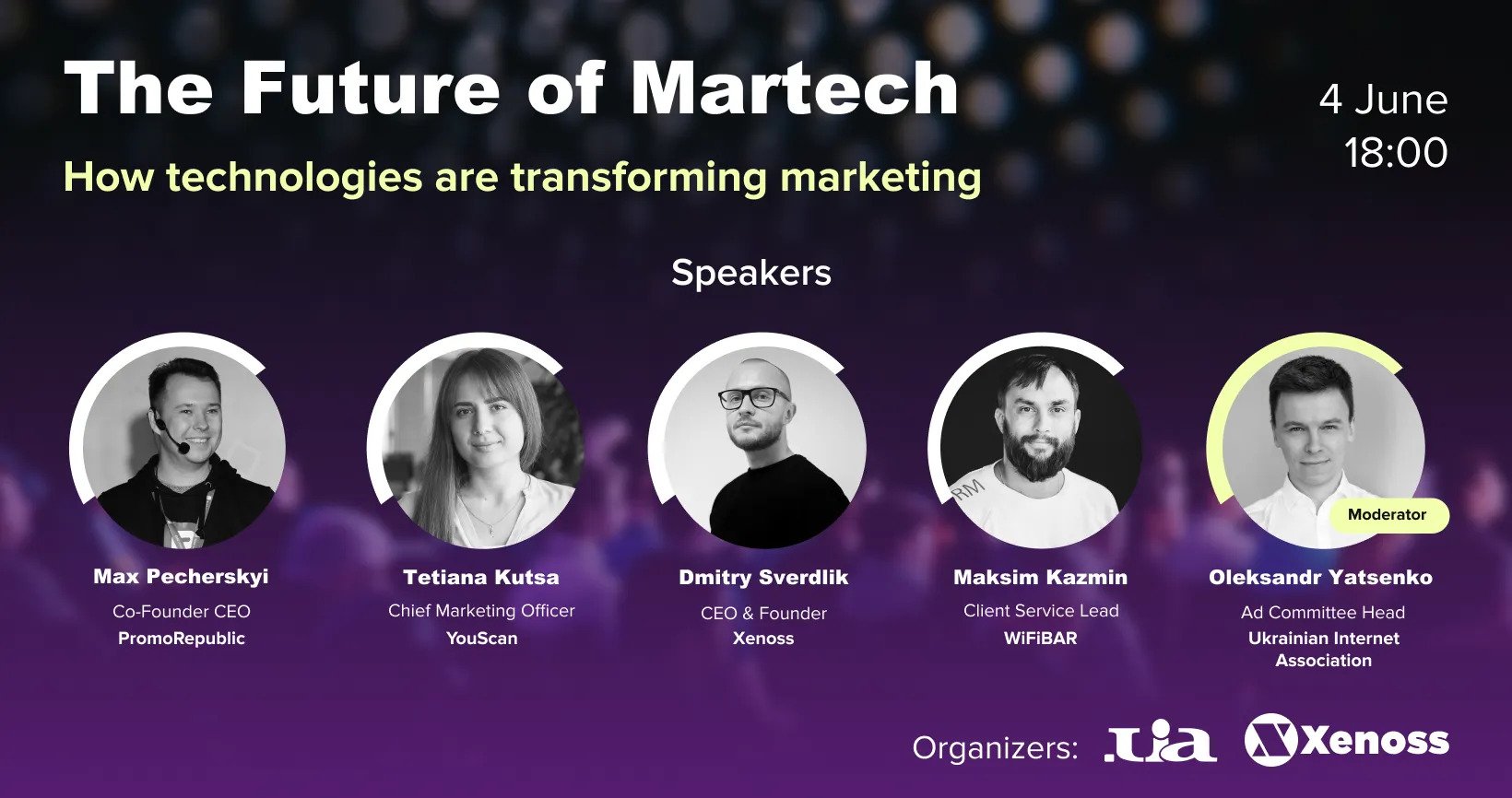On June 4, we at Xenoss held our first virtual meetup of the MarTech Discussion Club dedicated to “The Future of MarTech”, organized in partnership with the Internet Association of Ukraine (InAU). The goal of our meetups is to not only educate and share knowledge but also build a strong local community of MarTech professionals that is able to drive change and keep up with the rapidly evolving industry. Our team gathered leading industry experts to discuss the latest trends and advancements in marketing technology. Our guest speakers were:
- Dmitry Sverdlik, Xenoss CEO & Co-founder
- Tetiana Kutsa, Chief Marketing Officer of YouScan, a global social media monitoring and analysis service
- Max Pecherskyi, CEO & Co-founder of PromoRepublic, which offers an SMM automatization platform
- Maksim Kazmin, a Client Service Lead at WIFIBAR, an advertising platform based on WI-FI/3G/LTE.
Today we are bringing you the most important highlights from our discussion. If you’d like to join our virtual meetup next time, be sure to follow us on social media (Facebook, LinkedIn) for swift updates about future events. You can also watch the recording of the meetup on our YouTube channel. When we are talking about MarTech solutions, they ought to be considered as a complementary service rather than the end goal of marketing. Dmitry Sverdlik outlined buyer behavior trends that are changing modern marketing strategies and consequently inspiring innovative Martech.
According to Dmitry, the trends that are shaping the industry are:
– influence marketing software
– multi-channel marketing hubs
– hypersegmentation and precise targeting
– big data and smart analytics
– programmatic DOOH
– dynamic creative optimization
– retention technology
– augmented reality.
Wi-Fi advertising is a relatively new technology and it has found a large number of applications within MarTech. What Wi-Fi advertising does, is it enables brands to reach highly engaged mobile audiences while they are connected to a Wi-Fi network. The main goals of Wi-Fi advertising are consumer feedback, data congregation, analysis of location traffic, and contact with the audience prior to Wi-Fi network connection. As an expert on this technology, Maksim Kazmin, detailed the full scope of capabilities Wi-Fi advertising can provide. For example, hotspot technology WIFIBAR uses can provide advanced targeting based on time, device type, location, frequency, location segment, geo-targeting, OS, interests, social demographics, retargeting, and price range of the device. The method on which WIFIBAR’s technology operates is at first, as the user connects to the network an unskippable 7-second banner is displayed followed by another banner that gives the user two buttons – one to connect to the network immediately and the other to go to the advertiser’s page.
Maksim also mentioned WIFIBAR’s success in adapting its technology to work with mobile internet such as 3G/4G, which they were able to achieve by partnering with a mobile services provider. Despite the current situation, where people are spending less time outside, consequently using public Wi-Fi hotspots less, this technology is still adaptable and can work with mobile networks as well. Social media monitoring has evolved over the years and transformed from social media listening to social media intelligence. While the first-ever monitoring platforms were able to just gather data by keyword mentions, a social media listening platform is able to provide advertisers with analytics and insights including tone, demographics, spikes in mentions, etc. But listening platforms are not able to offer any context.
With that in mind, Tetiana Kutsa spoke on a relatively new area of social media intelligence and its capabilities based on practical examples. Social media intelligence is able to deliver insights into the context of mentions and discussions of a particular brand or keyword. While previously, monitoring platforms were able to only analyze brand logos in images, now almost every aspect of the image can be processed and identified. Drawing upon marketer feedback, Tetiana expects social media intelligence platforms to not only provide analytics but also make recommendations or even calls to action.
Social distancing brought along some changes in social media marketing. According to Max Pecherskyi, small businesses primarily remained unchanged in their approach. While ad agencies didn’t seem to know how to act at first, they later reacted by pushing the idea of going digital-first and sales to small businesses. And big enterprises slowed down business negotiations with PromoRepublic, yet resumed them within a month, which shows that big brands understand the importance of constantly reminding consumers of their business. The webinar concluded with a final Q&A with the speakers.
We thank our guests for sharing their insights and helping the Martech community stay on top of the challenges and changes in the robust Martech ecosystem. For us, this is just the beginning and the first among many Martech community events we’ll be organizing. Stay tuned for updates on what’s next!
About Xenoss
Xenoss is a MarTech/AdTech software development and consulting company. We build custom software for technology vendors, media, agencies, brands, and publishers, including Activision Blizzard, Verve Group, Smartly, Voodoo, Venatus, and others. The software delivered by the team is the tech basis of multi-billion dollar businesses and is used by well-established enterprises, including Nestlé, Adidas, Virgin, Uber, and HSBC.
If you want to develop a new product, improve your existing platform, or overcome various technical challenges, contact us at hello@xenoss.io.
